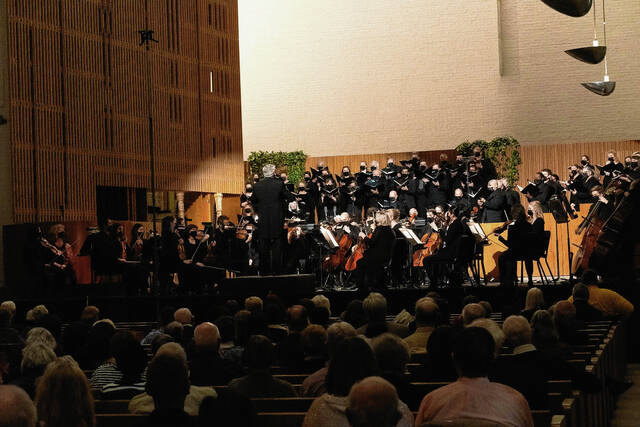It comes as no surprise that, in David Bowden’s final year as conductor of the Columbus Philharmonic Orchestra, audiences are hearing composers and works that are dear to him, as was Saturday’s performance of Johannes Brahms “A German Requiem.”
This is a composition offering comfort to those who, like Brahms, have lost loved ones, including the Philharmonic Orchestra, which has dedicated this performance in memory of the late Kevin Butler, director of music at First United Methodist Church, member of the Philharmonic Chorus, and who endeared himself to many young people in the field of musical theatre.
The soloists were Cathy Berns Rund, soprano, well-known to philharmonic audiences, and baritone Bruno Sandes, a doctoral student at the Indiana University Jacobs School of Music making his first appearance with the orchestra. In discussing this performance with David, he adheres to Brahms’ orchestration and his tempo markings, which are quicker than contemporary performance practice. The venue was First Christian Church with its famous acoustics and historic pipe organ.
The Philharmonic Chorus was outstanding from their very first entrance of “Blessed are They” that bathed the listener in a beautiful ensemble with articulate diction. No small consideration, for the singers were all masked following COVID protocol. The second movement, “All Flesh is like Grass” started in a minor key and was punctuated by restless percussion that moved toward a dramatic crescendo that bursts through with the full choir announcing, “The Redeemed of the Lord.” The following intricate fugal section was thrilling.
The third movement, like the second, starts by reflecting the frailty of humankind, but concludes with the promises of God. Bruno Sandes’ baritone voice was perfect for this movement as it set forth the text from Psalm 39, “Lord, let me know my end,” and was sung in an introspective manner that adhered to the text. The chorus and orchestra concluded the final section “For the Righteous,” and here we heard Brahms’ use of the contrabassoon and organ to reinforce the bass line. Brahms often used the contrabassoon to reinforce low registers in a way that defines clarity without thickening texture. Graydon Howard, the contrabassoonist, had a prominent role in this performance. Less so was the organ, but where called for, was most effective, as in the end of this movement.
The most familiar movement was the beautiful “How Lovely is Thy Dwelling Place.” Most choristers have sung this several times, but usually at a slower tempo than indicated by Brahms.
Thus, Bowden conducted the movement in quarter notes to ensure the prescribed tempo allowing arched phrases and a more dramatic agitato section. The fifth movement was the last Brahms composed as a tribute to his mother. The solo line was performed with great beauty and emotion by Berns Rund, whose projection, clarity, and warmth in the lower registers was powerful. The fortissimo treatment in “Look Upon Me” was thought by some to be too loud and penetrating, but Brahms calls for a “musical scream” at this point, and it certainly was.
The sixth movement is intricate like the second. It began with the baritone singing the Hebrews text, “We have on earth no enduring resting place.” It continued to build through various prophetic texts until the full ensemble announced, “death is swallowed up in victory!” The movement proceeded with an elaborate fugal section, which was breathtaking as the orchestra and chorus continued in full bore to the final statement from Revelations – “all things have their being and are created.”
The pinnacle point of the requiem, the seventh movement, followed directly echoing the sentiments of the first movement in both text, “Blessed are the dead,” and compositional style. The comforting sonorities of this movement brought the entire work to a peaceful and restful end.
This performance was the best I have heard. The Philharmonic Chorus was superb. The orchestra was splendid throughout, though with some minor glitches. A sloppy entrance by a few strings on the very opening chord was one that was uncomfortable. The woodwinds and particularly the oboist, Liza Saracina were outstanding, along with tympanist Brian McNulty. I look forward to the release of the recording of this outstanding concert.
Brown County resident Tom Wood has a master’s degree in organ performance from Indiana University’s Jacobs School of Music and served as president of Goulding and Wood Inc. Pipe Organ Builders until retirement.





